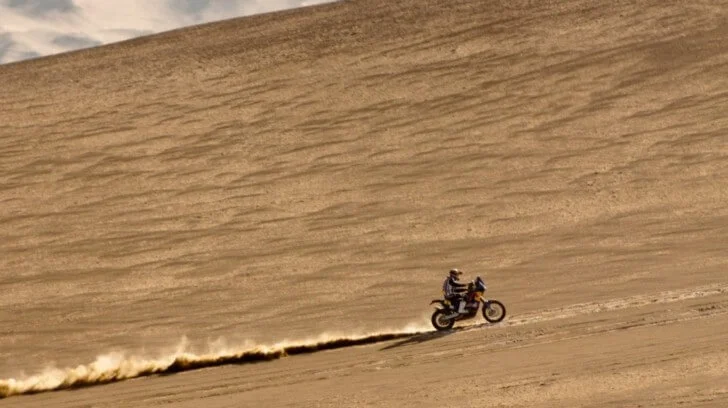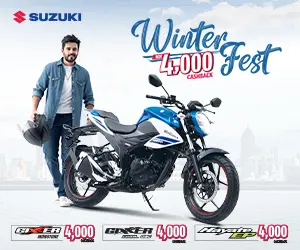Shares 2
Bike Riding in hot weather
Last updated on 04-Sep-2024 , By Shuvo
Bike Riding in hot weather is very tough for a rider or his passengers because he has to go through some difficulties and the hot weather isn’t at all good for the rider’s health. Some factors that may cause harm to the rider’s health are described below – Sweating is one of the main reason that causes harm to the health,The body has sweat glands to keep the skin damp.
Bike Riding In Hot Weather

The evaporating sweat sucks heat from the skin, and transfers it to the air. Of course sweat is primarily water, so it’s critical to keep replenishing the supply. That's one reason why we need to drink about a pint of water every hour during hot, dry conditions. One problem for motorcyclists is that at highway speed, the sweat glands may not keep up with the evaporation. Or, if the sweating uses up too much water, your body temperature regulating system goes on the fritz, like a dry battery.

To help cool down the core, blood vessels enlarge to circulate more blood towards the skin. If ambient air temperature is lower than body temperature, excess heat can be absorbed by the air. But if the air gets hotter than the skin, the increased blood flow simply soaks up more heat from the air and pumps it back to the core. thus Vasodilatation occurs. The heart responds to increasing heat ("hyperthermia") by increasing the heart rate to pump more blood into those enlarged blood vessels.
As the air temperature rises, heart rate (pulse) can increase 50% to 70% faster than the normal resting rate. The increased flow causes blood pressure to drop, and blood flow is shunted away from muscles and brain, towards the skin. The human body won't take much of an increase in core temperature without complaining. The symptoms of overheating are leg cramps, tired muscles, headaches, dizziness, and even fainting.

The various symptoms are trying to tell you how overcooked you're getting. Muscle cramps caused by heat usually effect the legs and lower abdomen first, then the arms. Heat cramps are a symptom that the body's electrolytes are running low. It’s not smart to ignore muscle cramps. Find some shade and take a break. Sip water or an "exercise" drink Exert firm pressure or massage the cramped muscles to relieve the spasms. If you’re still in pain, the recommended first aid dose is 1/2 teaspoon of table salt per half glass of water every 15 minutes.
Heat exhaustion occurs as the body continues to shunt blood away from the brain and muscles. Symptoms of heat exhaustion include: 1. Headaches, dizziness, nausea, momentary fainting 2. Cramps 3. Tiredness, weakness 4. Profuse sweating 5. Pale, clammy skin 6. Approximately normal body temperature If you begin to feel these symptoms during a desert ride, take immediate action before you pass out.
1. Get into some shade, preferably into an air-conditioned room.
2. Loosen clothing and wet down skin or undershirt to increase evaporative cooling.
3. Slowly sip water, or salt water solution, same dose as for heat cramps. Avoid alcohol or caffeine.
4. If you feel faint, lie down and get feet raised above head level.
5. If you can’t keep the salt water down, get emergency medical aid. You may need an intravenous salt solution.
6. Even after you begin to feel normal again, consider staying out of the heat for a day or two. Your body needs some time to recuperate. If you are on a long trip, consider a 24 hour layover in the next air-conditioned motel If you experience heat exhaustion and just try to "tough out" the heat without getting cooled down and rehydrated, the body thermostats will begin to fail.
Core temperature continues to rise (may go as high as 106 or 107 degrees F.), sweating stops, the heart beats even faster, and you may pass out. If you are coherent enough to recognize the symptoms, immediately get medical aid while you are still mobile. And watch your riding buddies for any of the following heat stroke symptoms.
1. Victim incoherent, staring vacantly, blanking out, or unresponsive
2. Skin hot, red, dry (no perspiration)
3. Rapid pulse
4. Body temperature elevated Yes, heat stroke is life threatening. It’s a medical emergency. Don’t be bashful about calling your doctor for assistance.
In the meanwhile,
1. Get the victim into some shade, out of riding gear, and cooled down by any means available. If possible, get the victim into an air-conditioned room, or use fans to help provide evaporative cooling.
2. Repeatedly sponge skin with cool water or rubbing alcohol. Apply cold packs or ice cubes if you can get them. The goal is to get body temperature below 102 degrees F.
3. Don't give the victim any stimulants, especially not any alcoholic beverages.
4. If the victim's temperature begins to rise again, repeat the cooling process.
5. As soon as possible, get the victim to emergency treatment. Avoiding the Ugliness In general, higher elevations are cooler. If it’s really hot down on the valley floor, consider an alternate road with a higher (cooler) elevation.
Sometimes you don’t have any alternative other than crossing a desert. But you can adjust your schedule. One tactic is to hibernate at a cool motel during the heat of the day, and head out after dark, when the temperature is lower. If you live in a temperate area where the thermometer seldom rises above 90F, you need to readjust your thinking for those forays into hotter territory. Remember, insulate your skin from the sun and hot air, use evaporative cooling around your neck, and drink lots of water. Oh yeh, learn to ignore the stares of other motorists and dehydrated bikers who think you’re crazy to wear heavy gear while Bike Riding in hot weather.
T
Published by Shuvo














